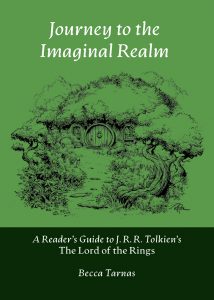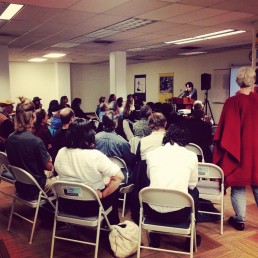Journey to the Imaginal Realm with Becca Tarnas
 The second volume of the Nuralogical series, Journey to the Imaginal Realm by Becca Tarnas, is launching into the world this September 22, 2019. And starting September 29, join Dr Tarnas for an extended, guided journey through Middle-earth at Nura Learning.
The second volume of the Nuralogical series, Journey to the Imaginal Realm by Becca Tarnas, is launching into the world this September 22, 2019. And starting September 29, join Dr Tarnas for an extended, guided journey through Middle-earth at Nura Learning.
In this book, journey into the world of Middle-earth, explore the grand themes and hidden nuances of J. R. R. Tolkien’s epic story, see The Lord of the Rings in the context of the larger mythology of Middle-earth, and delve into Tolkien’s writing process and his powerful experiences of the imaginal realm.
Beloved to several generations since its mid-1950s debut, The Lord of the Rings is a timeless story, engaging with a complex struggle between good and evil, death and immortality, power and freedom. Many treat The Lord of the Rings as a sacred text, returning to it year after year, or reading it aloud with loved ones. The Lord of the Rings has become a myth for our time.
In Journey to the Imaginal Realm, Becca Tarnas guides you through each chapter of Tolkien’s magnum opus, drawing attention to subtle details, recalling moments of foreshadowing, and illuminating underlying patterns and narrative threads. Her close reading of the text is paired with relevant biographical information from Tolkien’s life. Journey to the Imaginal Realm is a celebration of Tolkien’s work, and an inquiry into the profound nature of an imagination capable of bringing forth a world as vast as Middle-earth.
Comprised of six main chapters with several interludes and an in-depth biographical introduction, Tarnas's book canvases the landscape of Tolkien's legendarium, accompanied by six newly commissioned illustrations by Arik Roper.
Please enjoy this excerpt and pre-order your copy of Becca's book today!
Interlude:
Sub-creation: Tolkien’s Philosophy of Imagination
Before continuing with the story in Book II, I wish first to explore J. R. R. Tolkien’s own understanding of his creative process. Tolkien developed a theory of imagination that he called “Sub-creation” as a way to understand the origin and creation of his stories, which he explicated in his essay “On Fairy-Stories.” Tolkien defines “Imagination” as “the faculty of conceiving images,” and “the mental power of image-making.”1 Yet he points out that over time the term “Imagination” has come to mean something more than the faculty of image-making. The term carries a greater potency: “the power of giving to ideal creations the inner consistency of reality.”2 Tolkien is alluding to the English Romantic poet Samuel Taylor Coleridge, and his discussion of the primary and secondary imagination as expressed in Coleridge’s book Biographia Literaria. Coleridge delineates the primary imagination from the secondary imagination as a difference in degree, but not a difference in kind.
Coleridge defined the primary imagination as follows: “The primary Imagination I hold to be the living power and prime agent of all human perception, and as a repetition in the finite mind of the eternal act of creation in the infinite I AM.”3 Coleridge is saying that the primary imagination creates the world we perceive, and shapes our very perception of it. The primary imagination gives to “ideal creations the inner consistency of reality,” as Tolkien puts it. The primary imagination is the source of all images, the wellspring of creativity.
In Biographia Literaria Coleridge also delineates the secondary imagination, which he considers to be an “echo” of the primary imagination. Coleridge says that the secondary imagination is “co-existing with the conscious will, yet still as identical with the primary in the kind of its agency, and differing only in degree, and in the mode of its operation. It dissolves, diffuses, dissipates, in order to recreate.”4 The secondary imagination is the creative will of the human being, which takes the primary source of images and shapes it into art, bringing forth new form. Tolkien’s theory of sub-creation echoes Coleridge’s definitions of the primary and secondary imagination, although it is important to note that Tolkien chooses different terms for his concepts. Sub-creation is essentially a process in two primary stages: the experience of images arising through the “Imagination,” and then the “Art” of shaping those images into the final result. Tolkien calls the final result “Sub-creative Art.”5 The two stages are “Imagination” and then “Art,” and the result is a “Sub-creation.” Yet Tolkien wanted another word that could simultaneously encompass this “Sub-creative Art” and also what he called that “quality of strangeness and wonder in the Expression, derived from the Image.”6 For this word, a word that could encompass all those qualities, Tolkien chose the term “Fantasy.”7
The word “Fantasy” has a wide range of meanings for Tolkien. From his perspective, Fantasy is “the making or glimpsing of Other-worlds.”8 Fantasy is both an activity and the result of that activity. Fantasy is the capacity to create, but also to perceive, an otherworld; and it encompasses the full sensory experience of that otherworld. As Tolkien writes: “Fantasy is a natural human activity. It certainly does not destroy or even insult Reason; and it does not either blunt the appetite for, nor obscure the perception of, scientific verity.”9 Tolkien is careful to differentiate fantasy from dreaming, and to distinguish it also from delusion, hallucination, and mental disorders: “Fantasy is a rational not an irrational activity.”10 Fantasy requires conscious engagement and control by means of the human will. And, as I mentioned previously, fantasy is also the word Tolkien chose to encompass what he meant by “Sub-creative Art.” Thus “Fantasy” is a noun, an adjective, and a verb in Tolkien’s vocabulary, and encompasses the full experience of “making or glimpsing Other-worlds.”
According to Tolkien, a successful sub-creator “makes a Secondary World which your mind can enter. Inside it, what he relates is ‘true’: it accords with the laws of that world. You therefore believe it, while you are, as it were, inside.”11 Tolkien calls this occurrence “Secondary Belief.”12 Secondary belief is what we experience when we read a great story, a story such as The Lord of the Rings. We are able to enter into the world of Middle-earth. When one enters a secondary world, and the inner laws of that world are consistent, it feels as though one is truly in that place, seeing the landscapes, hearing the people speaking and interacting with one another, and witnessing events unfold through one’s internal sensory perceptions. A true secondary world echoes the primary world in its expression of reality.
From Tolkien’s perspective, there is yet another level of secondary belief. When secondary belief reaches its most actualized form, then one experiences “Enchantment.” Tolkien writes: “Enchantment produces a Secondary World into which both designer and spectator can enter, to the satisfaction of their senses while they are inside; but in its purity it is artistic in desire and purpose.”13 Enchantment allows one to be fully immersed in a secondary world, beyond any doubt in its reality. Enchantment is what Frodo experiences in the first chapter of Book II, in the Hall of Fire when he hears the Elvish music and visions begin to unfold before him.14 He knows the story being told even though he does not understand all the Elvish words. That is an experience of enchantment, or what Tolkien also at times calls a Faërian Drama.15
Tolkien only uses the term Faërian Drama in a few places, in the essay “On Fairy-Stories” and in his unfinished tale The Notion Club Papers that he wrote in the early 1940s. But the term seems to indicate a kind of visionary experience, or what Tolkien would call a “waking dream.”16 Tolkien is elusive in the way that he speaks about Faërian Drama and Elvish Enchantment, never quite committing to saying this is something that can occur in the real world. Tolkien presents Faërian Drama as a real experience, but he speaks of Elves and the realm of Faërie in a dual and even contradictory way, sometimes as though Elves are real and Faërie an actual place, other times as though they are merely the invention of the human imagination, existing only in a realm of unreality.17 In a few different essays and commentaries, the scholar Verlyn Flieger has engaged with Tolkien’s most contradictory and paradoxical statements in “On Fairy-Stories,” drawing not only on his published text, but on the earlier manuscript drafts of the essay as well. Flieger notes: “Anticipating a skeptical reception, Tolkien tries in the essay as in his letters to have it both ways, on the one hand treating elves as real beings independent of humanity, and on the other hand saying that they are products of human imagination.”18 He is never clear where he stands, expressing the ambiguity of his position in the modern era. In the modernity of Tolkien’s time, secular disenchantment and religious tradition stood as pillars of a world view undergoing deep transformation.
Tolkien uses the term “Sub-creation” because, as a devout Catholic, Tolkien saw himself and other artists and authors as creators under God. Such artists are not the instigators of primary Creation, but rather instruments through whom the divine imagination can be channeled and shaped. Tolkien illustrates this idea in a series of lines from his poem Mythopoeia:
Man, Sub-creator, the refracted Light
through whom is splintered from a single White
to many hues, and endlessly combined
in living shapes that move from mind to mind.19
The human being is able to refract and reshape the divine inspiration into art and creative works, which then continue to refract as others participate in that art. Our reading of The Lord of the Rings, and our experience of seeing the images that arise when we engage in the story, are such a creative participation. We are each prisms, shaping the light of God into an iridescent infinity of sub-creations. Yet those sub-creations also contain within them the primal creative white light of God, the source of the primary imagination.
Tolkien said that literature might be the best medium for sub-creation because of its ability to evoke images directly from the imagination of the reader. The written or spoken word can communicate a universal and a particular simultaneously.20 The word is both concrete and fluid, and leaps from imagination to imagination. As Tolkien eloquently explicates:
Literature works from mind to mind and is thus more progenitive. It is at once more universal and more poignantly particular. If it speaks of bread or wine or stone or tree, it appeals to the whole of these things, to their ideas; yet each hearer will give to them a peculiar personal embodiment in his imagination. . . . If a story says “he climbed a hill and saw a river in the valley below,” the illustrator may catch, or nearly catch, his own vision of such a scene; but every hearer of the words will have his own picture, and it will be made out of all the hills and rivers and dales he has ever seen, but especially out of The Hill, The River, The Valley which were for him the first embodiment of the word.21
One can hear the archetypal to which Tolkien is speaking in this passage: The Hill, The River, The Valley are all capitalized in that final sentence. The written word is able to communicate not only the particular images as they arise in the imagination of the author, but it also connects to the universal or the archetype behind that unique image. The image communicated thus has both a quality of being ancient or even eternal, but also of being newly made or perceived in that moment.
About the author
Becca Tarnas, phd, is a scholar, artist, and editor of Archai: The Journal of Archetypal Cosmology. She received her doctorate in Philosophy and Religion from the California Institute of Integral Studies. Her research interests include depth psychology, literature, philosophy, and the ecological imagination. She teaches in the Jungian Psychology and Archetypal Studies program at Pacifica Graduate Institute, and for online platforms such as Nura Learning, PsicoCymática, and the Astrology Hub. Becca lives in Nevada City, California.
Pre-order your copy of Journey to the Imaginal Realm today!
Notes:
1 Tolkien, On Fairy-Stories, 59.
2 Tolkien, On Fairy-Stories, 59.
3 Samuel Taylor Coleridge, Biographia Literaria (London: J.M. Dent & Co., 1906), 159–60.
4 Coleridge, Biographia Literaria, 159.
5 Tolkien, On Fairy-Stories, 59.
6 Tolkien, On Fairy-Stories, 60.
7 Tolkien, On Fairy-Stories, 60.
8 Tolkien, On Fairy-Stories, 55.
9 Tolkien, On Fairy-Stories, 65.
10 Tolkien, On Fairy-Stories, 60, n. 2.
11 Tolkien, On Fairy-Stories, 52.
12 Tolkien, On Fairy-Stories, 64.
13 Tolkien, On Fairy-Stories, 64.
14 Tolkien, The Fellowship of the Ring, II, i, 227.
15 Tolkien, On Fairy-Stories, 63; Tolkien, “The Notion Club Papers,” 193.
16 Tolkien, The Fellowship of the Ring, I, iii, 81.
17 Tolkien, On Fairy-Stories, 32.
18 Verlyn Flieger, “But What Did He Really Mean?” Tolkien Studies 11 (2014): 155.
19 Tolkien, On Fairy Stories, 65.
20 Tolkien, On Fairy-Stories, 61.
21 Tolkien, On Fairy-Stories, 82, n. E.
Welcoming Jeremy Johnson to Revelore
 Jeremy Johnson is an editor, essayist, and culture writer. His work explores the borders of the human and non-human worlds, liminal spaces, and the imagination as a window into latent futures. He is the founder of Nura Learning, a conscious media platform promoting education as an agent of personal and cultural transformation. Jeremy has a Consciousness Studies MA from Goddard College, and is the current president of the International Jean Gebser Society. Jeremy is also a contributing editor to Reality Sandwich magazine, and his writing has appeared in publications such as OMNI, Evolve Magazine, Conscious Lifestyle Mag, Kosmos Journal, Evolve and Ascend, and Disinformation.
Jeremy Johnson is an editor, essayist, and culture writer. His work explores the borders of the human and non-human worlds, liminal spaces, and the imagination as a window into latent futures. He is the founder of Nura Learning, a conscious media platform promoting education as an agent of personal and cultural transformation. Jeremy has a Consciousness Studies MA from Goddard College, and is the current president of the International Jean Gebser Society. Jeremy is also a contributing editor to Reality Sandwich magazine, and his writing has appeared in publications such as OMNI, Evolve Magazine, Conscious Lifestyle Mag, Kosmos Journal, Evolve and Ascend, and Disinformation.
~
Jeremy, we are so thrilled that you’ve joined the Revelore team. You have chosen to become the Curator of Philosophies. What does that mean to you, and, really, how did you arrive here?



